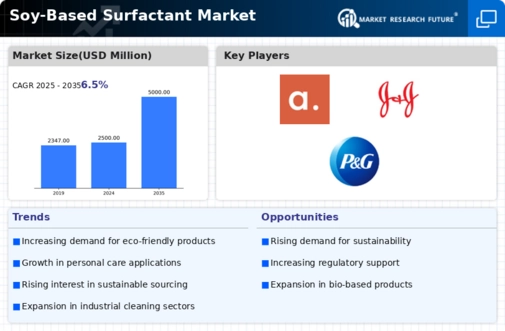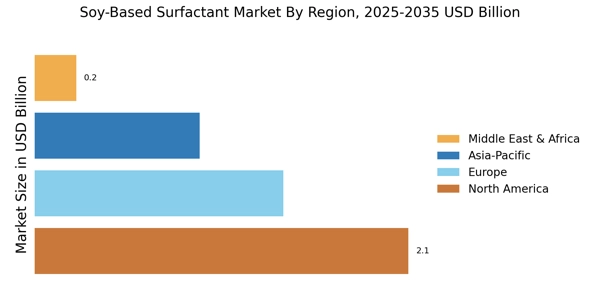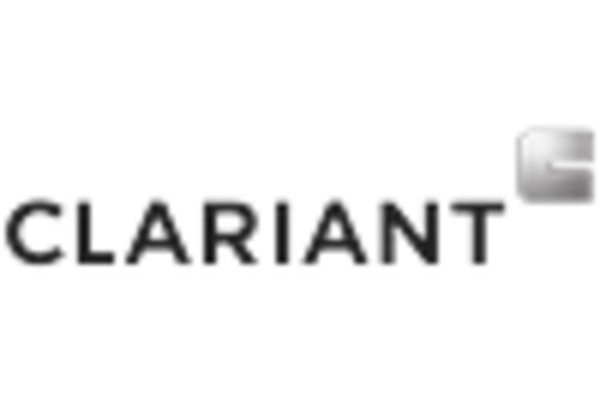Growing Applications in Diverse Industries
The versatility of soy-based surfactants is driving their adoption across a multitude of industries, thereby expanding the Soy-Based Surfactant Market. These surfactants are increasingly utilized in personal care, agriculture, and industrial cleaning applications due to their effective performance and eco-friendly profile. The personal care sector, in particular, is projected to account for a significant share of the market, with an expected growth rate of 6% annually. This diversification of applications not only broadens the customer base but also enhances the overall market potential for soy-based surfactants. As industries continue to seek sustainable alternatives, the Soy-Based Surfactant Market is likely to experience robust growth fueled by this expanding range of applications.
Rising Consumer Awareness of Sustainability
The Soy-Based Surfactant Market is experiencing a notable shift as consumers increasingly prioritize sustainability in their purchasing decisions. This heightened awareness is driving demand for eco-friendly products, including those derived from renewable resources like soy. As consumers become more informed about the environmental impact of their choices, they are likely to favor products that utilize soy-based surfactants over traditional petrochemical alternatives. This trend is reflected in market data, which indicates that the demand for sustainable surfactants is projected to grow at a compound annual growth rate of approximately 5% over the next five years. Consequently, manufacturers in the Soy-Based Surfactant Market are adapting their product lines to meet this evolving consumer preference, thereby enhancing their market competitiveness.
Regulatory Support for Sustainable Practices
The Soy-Based Surfactant Market is benefiting from an increasingly supportive regulatory environment that encourages the use of sustainable materials. Governments and regulatory bodies are implementing policies aimed at reducing carbon footprints and promoting the use of biodegradable products. This regulatory support is likely to incentivize manufacturers to invest in soy-based surfactants, as they align with sustainability goals. For instance, various regions have introduced incentives for companies that adopt eco-friendly practices, which could lead to a significant increase in the market share of soy-based products. As a result, the Soy-Based Surfactant Market is poised for growth, with projections suggesting a potential increase in market size by 10% within the next few years due to these favorable regulations.
Increased Investment in Research and Development
The Soy-Based Surfactant Market is witnessing a surge in investment directed towards research and development initiatives. Companies are increasingly recognizing the importance of innovation in creating new formulations and improving existing products. This focus on R&D is essential for enhancing the performance characteristics of soy-based surfactants, making them more appealing to consumers and industries alike. Market analysis indicates that R&D expenditures in this sector could rise by 20% over the next few years, reflecting a commitment to advancing product efficacy and sustainability. As a result, the Soy-Based Surfactant Market is likely to benefit from a continuous influx of innovative products that meet the evolving needs of consumers and businesses.
Technological Advancements in Production Processes
The Soy-Based Surfactant Market is witnessing a wave of technological advancements that enhance the efficiency and effectiveness of production processes. Innovations in extraction and processing techniques are enabling manufacturers to produce high-quality soy-based surfactants at lower costs. These advancements not only improve the economic viability of soy-based products but also contribute to their appeal in various applications, including personal care and household cleaning. Market data suggests that the introduction of new technologies could lead to a reduction in production costs by up to 15%, thereby making soy-based surfactants more competitive against traditional alternatives. This trend indicates a promising future for the Soy-Based Surfactant Market as it continues to evolve and adapt to changing market demands.


















Leave a Comment